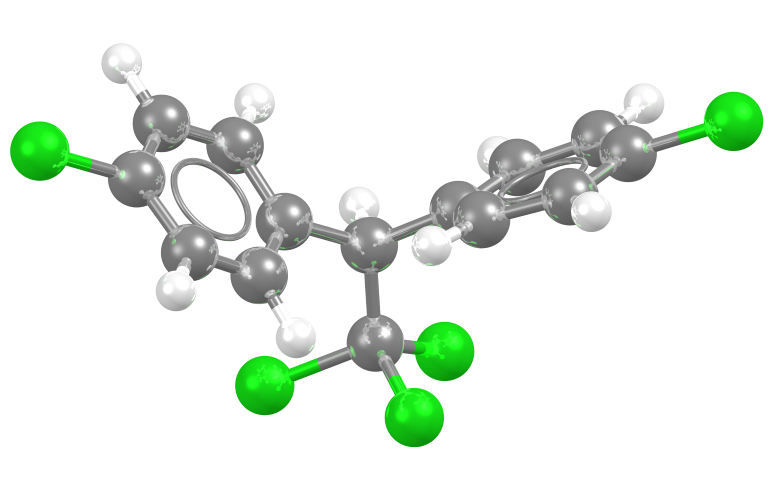Chlorine
Chlorine:

A “Chlorine tablet” used for swimming pools – this is in fact the compound dichlor, in which the Chlorine hydrolyses on contact with water and forms the biocide hypochlorous acid (HOCl).
Facts about Chlorine:
- Chlorine: yellow-green gas at standard conditions
- Fun fact about Chlorine: The World Health Organisation states that water chlorination played a key role in extending life expectancy by over 30 years (to 77 in the US) during the 20th century
- Chemical symbol: Cl
- Atomic number: 17
A crystal structure containing Chlorine:

The original structure of DDT (the new form has two slightly differently shaped molecules in the crystal)
Facts about this structure:
- Formula: C14H9Cl5
- Structure name: 1,1,1-trichloro-2,2-bis(4-chlorophenyl)ethane or DDT
- Fun fact about the structure: DDT (traditionally known as dichlorodiphenyltrichloroethane) was discovered in 1874 and immediately recognised as a pesticide. Almost 100 years (1972) later its crystal structure was reported. However, in 2017 a new crystal form was discovered – it slowly converts to the original form, but is a more effective pesticide.
- CSD refcode: CPTCET12 (new form = CPTCET11</span>; original structure = CPTCET10) (What’s this?)
- Associated publication: J. Yang, C. T. Hu, X. Zhu, Q. Zhu, M. D. Ward, B. Kahr, Angewandte Chemie Int. Ed. (2017), 56, 10165-10169, DOI: 10.1002/anie.201703028
More about Chlorine:
Chlorine is a gas at room temperature and pressure, perhaps best known for use as chemical warefare agent in World War I. However, in the last century chlorine has saved many more lives than it has claimed. Chlorine containing compounds are widely used in a range of disinfectants and for public sanitation. Chlorine tablets used to purify drinking water are typically sodium dichloroisiocyanurate, which slowly releases chlorine when dissolved in water. Salt (NaCl) is by far the most common compound of chlorine (and is of course commonly found in crystalline form!) and about 20% of chlorine is used to make PVC (polyvinyl chloride).
Learn More About the International Year of the Periodic Table (IYPT) in Crystals Project:
This project (#IYPTCrystals) is part of the International Year of the Periodic Table celebration (#IYPT2019), read more about the project here.
You can follow us on social media; search for #IYPTCrystals or follow The CCDC on X @ccdc_cambridge on Facebook ccdc.cambridge, on Instagram ccdc_cambridge or on YouTube CCDCCambridge.
Understand some of the terms and concepts used with our Frequently Asked Questions page here.
A 3D visualization showing Chlorine in real crystal structures: